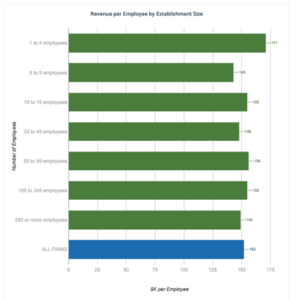A Key Performance Indicator to Improve the Results of your Testing Lab Exit
When preparing to sell your Testing Laboratory using Key Performance Indicators (KPIs) can help to focus your efforts and resources in the right areas. While numerous KPIs exist, one metric that should be on the radar of all business owners in the testing laboratory industry is the Sales/Employee Ratio. Labor costs make up the largest single expense for Laboratory Testing businesses, accounting for an estimated 38.4% of industry revenue in 2022 (IBIS WORLD July 2022). For lab owners, monitoring labor costs is critical to improve financial performance and improve business valuations. This KPI is simple to calculate, easy to understand, and offers valuable insights into a company’s efficiency, productivity, and overall financial health.
Defining the Sales/Employee Ratio:
The Sales/Employee Ratio, also known as Sales per Full-Time Equivalent (FTE), measures the sales generated by a company divided by the total number of full-time employees. It provides a clear picture of how efficiently a business is utilizing its workforce to generate sales. The formula for calculating this ratio is straightforward:
Sales/Employee Ratio = Total Sales Revenue / Number of Full-Time Employees
Why Sales/Employee Ratio Matters:
- Efficiency and Productivity: A high Sales/Employee Ratio indicates that a company efficiently utilizes its human resources to generate revenue. It signifies that employees are productive, effective, and contributing significantly to the organization’s bottom line. A low ratio, on the other hand, could suggest inefficiency, underutilization of staff, or a need to optimize processes.
- Financial Performance: The Sales/Employee Ratio directly correlates with a company’s financial performance. By analyzing this KPI over time, businesses can identify trends, measure growth, and evaluate their competitiveness within the industry. A higher ratio indicates strong financial health, profitability, and the ability to generate revenue with fewer resources.
- Resource Allocation: The Sales/Employee Ratio can aid in resource allocation decisions. By benchmarking against industry standards and peers, businesses can determine whether they need to adjust their workforce size, invest in employee training, or streamline processes. This ratio can guide decision-making and help optimize human resource utilization.
- Scalability and Growth Potential: As businesses expand, the Sales/Employee Ratio becomes even more critical. It helps identify if the current workforce is capable of supporting growth or if additional employees are required to maintain efficiency. A consistent or improving ratio amidst growth indicates that a company has the potential for scalable operations without compromising productivity.
How to improve your company’s Sales/Employee Ratio:
Achieving and maintaining a favorable Sales/Employee Ratio requires a strategic approach. Here are some key considerations for improving this KPI:
- Training and Skill Development: Invest in training programs to enhance the skills and capabilities of your team. By improving their effectiveness, they can generate higher sales, and be more productive thereby increasing the Sales/Employee Ratio.
- Process Optimization: Continuously analyze and refine business processes to eliminate inefficiencies and bottlenecks. Streamline operations can lead to improved productivity and higher sales output per employee.
- Technology Adoption: Leverage technology solutions such as customer relationship management (CRM) systems, lab automation tools, and analytics platforms. These tools enable better customer management, data-driven decision-making, and increased production efficiency.
- Performance Incentives: Implement performance-based incentive programs to motivate employees and drive them towards achieving higher production targets. Aligning incentives with the Sales/Employee Ratio can create a culture of productivity and accountability.

Figure 1:US Testing Laboratories Sales/Employee VerticalIQ, May 2023, US Census
It is possible for the Sales/Employee Ratio to be too high. This could mean that the business is working their employees too hard or not investing sufficiently in business operations. Figure 1 above shows the average Sales/Employee for Testing Labs in the US based on the number of employees. This can serve as a benchmark for your company.
Conclusion:
The Sales/Employee Ratio is a powerful and simple-to-understand KPI for the owners of Testing Laboratories that want to improve their company’s financial performance in preparation for an exit. By monitoring and optimizing this ratio, business owners can make informed decisions about resource allocation, training, and growth strategies. It serves as a compass for sustainable success, helping organizations unlock the full potential of their workforce while driving revenue growth.
Exit Strategies Group helps the owners of Testing Laboratories to navigate their best exits. If you’d like to have a confidential, no commitment discussion on your exit plans or have related questions, please contact Adam Wiskind, Senior M&A Advisor at (707) 781-8744 or awiskind@exitstrategiesgroup.com.
Tags: KPI, testing laboratories, testing lab, exit, M&A, labor costs, sales, key performance indicator




